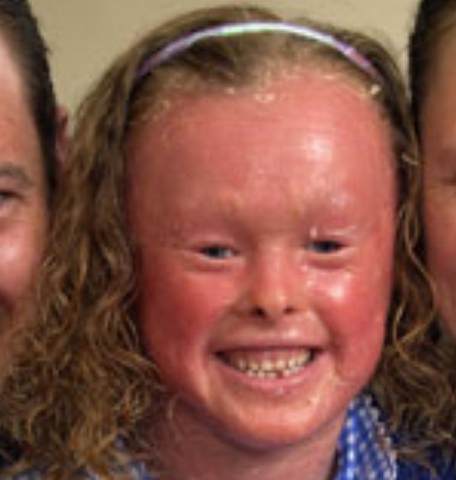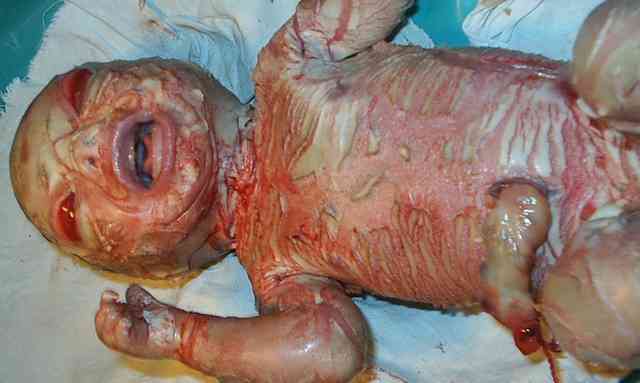Harlequin Ichthyosis – Pictures, Treatment, Causes and Symptoms
What is Harlequin Ichthyosis?
The largest organ of the body is the skin. It serves as our protector against viruses, bacteria, pollution and other elements. It also helps in maintaining the body’s temperature. These are some of the important functions that our skin offers. However, there are conditions that have impaired the function of the skin. One condition is that does this is called as Harlequin Ichthyosis(HI), Harlequin baby syndrome or Ichthyosis Fetalis, which is a rare and severe genetic disorder that affects the skin of the infants per se.
This condition prevents the skin from performing its primary function, which is as a protector. It prevents formation of protective layer. It produces, instead, a scale-like, hard. Diamond-shaped plates that are separated by ridges that is deep. The deep ridges compromise another skin’s essential function which is to be the body’s first line of defense. While the hard plates disrupt the other function of the skin which is to constantly slough off and replace the dead skin cells.
Sin the skin’s protective barrier is disrupted, the babies, who are diagnosed as having this kind of skin disorder, are susceptible to infection, at risk of dehydration because of increasing water loss and they have also impairment of temperature regulation. Hence, they are predisposed to extreme cold and heat.

Picture 1 – Harlequin Ichthyosis (face)
Harlequin Ichthyosis Symptoms & Signs
The main symptoms of harlequin ichthyosis are:
Dryness of Skin
The disorder causes dryness of the skin which will lead to scales and dehydration.
Scaly Skin
The disorder causes skin to scale which will lead to having fissure and causes itching and bleeding.
Anatomical Changes
The disorder is known to cause anatomical changes like having poor developed ears and round mouth.
Harlequin Ichthyosis in babies
Infants are the ones who are often triggered and reported of having this very rare skin disorder.
- The babies of harlequin ichthyosis are reportedly having a thick, hard skin covering in most part of their body.
- The skin has a diamond shaped, medically termed as harlequin, plates which are separated by deep fissures or cracks.
- It will greatly affect the shape of the ears, nose, eyelids, and it limits the movement of both legs and arms.
- It often pulls the baby’s mouth and makes it widely open.
- Aside from that, babies born with this skin disorder have microcephaly or small head and a deformed face.
- There will be restriction in the movement of the chest which will lead to difficulties in breathing and eventually will lead to respiratory failure.
Harlequin Ichthyosis Causes
The harlequin ichthyosis is known to be genetic in nature. The ABC 12 gene, which directs the protein production that is necessary to have a normal skin growth, is being mutated which leads to this severe skin disorder. It is a gene that is responsible for the transportation of lipid. When it mutates, it produces a harden protein called keratin. This is an autosomal recessive gene. Autosomal recessive gene means that the parents are carrier of the gene and that they both have one of the genes that they passed on to their baby. One must take note that this occur rarely. That child who doesn’t have the signs of symptoms of this skin disorder will either be a carrier of the gene itself.
The children who are inherited with this form of skin disorder will usually have at birth, a normal skin. They eventually develop roughness and scaling during the first few years of their life. At times it is intermittent. It appears in the infant years and disappears during the adult years, then returns later. It is usually associated with diseases like thyroid, chronic renal failure or cancer.
Harlequin Ichthyosis Diagnosis
Ultrasound to pregnant mother
In diagnosing this type of genetic skin disorder, the mother can undergo ultrasound. It is often the done to be able to diagnose early the baby’s condition prior to the baby’s birth.
Physical examination
Sometimes the diagnosis is made through physically examining your skin and characterizing the scales that is associated with this skin disorder.
Skin Biopsy
If still in doubt, the physician may perform other relevant test such as skin biopsy. This is necessary for him or her to rule out other etiology of the dry, scaly skin that these persons manifests.
Aside from the test that will be conducted, the physician will thoroughly assess you by asking important questions such as any personal or genetic history of ichthyosis, age when the ichthyosis first begun, and presence of other skin disorders.
Harlequin Ichthyosis Treatment
Airway maintainance
In treating this severe and very rare skin disorder, upon delivery, the baby’s airway and circulation is the number one priority. The healthcare team must ensure that the baby or the patient’s airway, breathing and circulation are in stable conditions. The babies will require intravenous access. It will be through this access where the medications will be given. It is necessary to have cannulation of the baby’s umbilicus. The healthcare team will place the babies or infants in an incubator that is humidified. Once the vital signs have stabilized, the baby is then transferred into a level 3 neonatal nursery station or room.
Protection of conjunctiva
It is necessary that the baby will be applied with ophthalmic lubricants in order to protect their conjunctiva. When bathing the baby having this skin disorder, it is advisable that he or she takes a bath twice a day and will use wet sodium chloride compresses frequently. It is then followed by applying bland lubricants to aid in softening the hard skin.Topical keratolytic medications are not to be prescribed in newborns because it has the potential to be toxic to the system.
Intravenous access for feeding
As mentioned, there is a need for intravenous access for intravenous fluids are often prescribed. Neonates diagnosed with this kind of skin disease, initially have feeding problems. There is a need to calculate daily fluid requirements since the neonates will experience excess cutaneous water losses. In addition to that, there is a need for serum electrolyte level monitoring. There is also a high risk of having hypernatremic dehydration. Lastly, there is a need to always maintain a sterile environment to avoid any infection to occur.
Harlequin Ichthyosis Pictures

Picture 2 – Harlequin Ichthyosis in newborn

Picture 3 – Harlequin Ichthyosis in infants

Picture 4 – Harlequin Ichthyosis (hand)